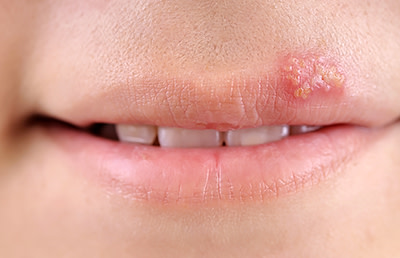Cold sores: Overview
What is a cold sore?
A cold sore is a small blister or group of blisters that usually develop on the lip or around the mouth. Cold sores are caused by the herpes simplex virus (HSV).
Cold sores are also known as fever blisters or herpes simplex labialis
If you get cold sores, you’re not alone. More than half of Americans ages 14 to 49 carry the virus that causes cold sores. The virus stays in the body after the cold sores clear. If the virus reactivates, or wakes up, you may get cold sores again.
Cold sores are generally not serious. In healthy people, cold sores tend to clear within two weeks.
Cold sore on and above the lip
Cold sores are so contagious that many people catch the virus that causes them by the time they’re 5 years old.

If you have a cold sore, you can spread the virus to others who don’t have the virus. Even when you treat cold sores, you can still spread the virus to others. You are contagious until all the sores have scabbed over.
By taking the following precautions until all of the sores have scabs, you can avoid infecting others:
Don't kiss people, especially children
Avoid other intimate contact
Avoid close contact with anyone who has a weakened immune system, including newborn babies
Don’t share personal items like lip balm, towels, or razors
Don’t share beverages or food
Try not to touch your cold sores
If you touch a cold sore or apply medicine to it, wash your hands immediately afterward
Wash your hands frequently throughout the day
These precautions are especially important if you are around a child who has eczema or someone who has a weakened immune system. If that person catches the virus, it can be very serious.
Related AAD resource
Image
Getty Images
References
American Academy of Dermatology. “Dermatologists share tips for treating cold sores.” News release issued April 15, 2015.
Fatahzadeh M and Schwartz RA. “Human herpes simplex virus infections: Epidemiology, pathogenesis, symptomatology, diagnosis, and management.” J Am Acad Dermatol. 2007;57(5):737-63.
 Atopic dermatitis: More FDA-approved treatments
Atopic dermatitis: More FDA-approved treatments
 Biosimilars: 14 FAQs
Biosimilars: 14 FAQs
 How to trim your nails
How to trim your nails
 Relieve uncontrollably itchy skin
Relieve uncontrollably itchy skin
 Fade dark spots
Fade dark spots
 Untreatable razor bumps or acne?
Untreatable razor bumps or acne?
 Tattoo removal
Tattoo removal
 Scar treatment
Scar treatment
 Free materials to help raise skin cancer awareness
Free materials to help raise skin cancer awareness
 Dermatologist-approved lesson plans, activities you can use
Dermatologist-approved lesson plans, activities you can use
 Find a Dermatologist
Find a Dermatologist
 What is a dermatologist?
What is a dermatologist?